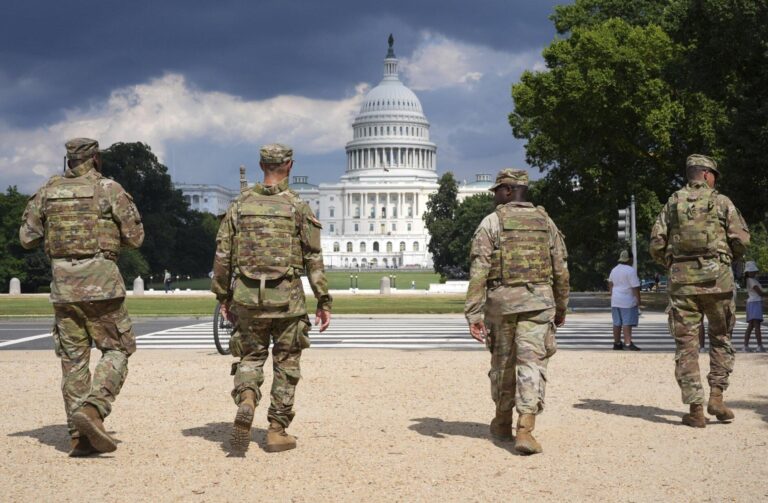National Guard Mobilized in Washington D.C. Amid Heightened Security Measures
In response to escalating unrest and security threats in the nation’s capital, the federal government has taken the extraordinary step of deploying the National Guard to Washington, D.C. Alongside this, control over the Capitol Police has been shifted to federal authorities, marking a significant transformation in the city’s security framework. This decisive action aims to strengthen protection around critical government sites and ensure a coordinated defense against potential disturbances.
Details of the National Guard Deployment and Federal Police Oversight
The President’s directive involves activating more than 5,000 National Guard personnel, equipped and prepared for rapid intervention. Federal officials have assumed command of the Metropolitan Police Department to streamline operations and enhance interagency collaboration. Heightened security protocols have been implemented around the Capitol complex and nearby federal buildings, supported by continuous communication channels linking city, state, and federal agencies.
- Activation of 5,000+ National Guard troops for immediate response
- Federal authority overseeing Capitol Police operations
- Enhanced security measures at key federal sites
- 24/7 coordination among multiple law enforcement bodies
| Security Component | Description |
|---|---|
| Troop Numbers | Over 5,000 National Guard members deployed |
| Police Command | Federal oversight established |
| Priority Zones | Capitol grounds and adjacent federal buildings |
| Communication | Continuous interagency coordination |
Debate Over Federal Control of Capitol Police Authority
The transfer of Capitol Police command to federal jurisdiction has ignited intense discussions among policymakers, civil liberties organizations, and security analysts. Advocates for the move highlight the benefits of unified command and increased resources to counteract rising threats. Conversely, opponents caution against the risks of politicizing law enforcement and diminishing local accountability, warning that this could erode the independence of the Capitol Police and set a concerning precedent for future federal interventions in municipal policing.
- Jurisdictional ambiguity: Local agencies express apprehension about losing clear operational control.
- Lack of transparency: Demands persist for explicit guidelines governing federal oversight powers.
- Concerns over civil rights: Activists fear increased surveillance and suppression of lawful protests near government buildings.
| Group | Stance | Primary Concerns |
|---|---|---|
| Federal Authorities | In favor | Improved security coordination |
| Capitol Police | Divided | Loss of autonomy and command confusion |
| Civil Rights Groups | Opposed | Potential misuse of authority and threats to free expression |
Effects on Local Policing and Community Trust
The National Guard’s presence and the federal assumption of Capitol Police control have significantly impacted the relationship between local law enforcement and the communities they serve. This shift has raised concerns about jurisdictional boundaries and the erosion of trust built through community policing efforts. Many local officers report feeling sidelined, which may hinder their ability to address neighborhood-specific concerns effectively under federal command.
Community advocates highlight several consequences of this realignment:
- Decline in community policing programs, weakening bonds between residents and officers.
- Increased suspicion and tension, especially among minority populations wary of federal intervention.
- Accountability challenges, as federal agencies supersede local protocols and oversight.
| Stakeholder | Main Concern | Immediate Impact |
|---|---|---|
| Local Police | Diminished operational control | Lowered morale and effectiveness |
| Community Organizations | Transparency erosion | Growing distrust toward law enforcement |
| Federal Agencies | Maintaining order amid unrest | Expanded jurisdiction and authority |
Expert Recommendations for Balancing Security and Civil Rights
Following the National Guard’s activation and the federal takeover of Capitol law enforcement, experts stress the necessity for clear, transparent protocols that safeguard both national security and individual freedoms. Legal scholars and security professionals advocate for a well-defined framework that specifies the responsibilities and limits of federal and local agencies during emergencies. Such measures are vital to prevent misuse of power while enabling an effective response to threats against democratic institutions.
- Defined command structures: Establishing clear leadership roles between federal and local forces.
- Accountability mechanisms: Instituting oversight to monitor military involvement in civilian areas.
- Regular independent reviews: Ensuring protection of civil liberties through external audits.
- Community involvement: Promoting transparency and dialogue to maintain public confidence in security efforts.
| Focus Area | Recommended Approach |
|---|---|
| Leadership | Clearly defined jurisdictional authority |
| Use of Force | Mandated proportionality and restraint |
| Public Transparency | Regular disclosure of security operations and policies |
Conclusion: Navigating Security Challenges in the Nation’s Capital
The recent mobilization of the National Guard and the federal assumption of Capitol Police command represent pivotal developments in Washington D.C.’s approach to maintaining order during turbulent times. These measures highlight the complex balance between ensuring public safety and preserving democratic principles. As the situation continues to unfold, ongoing dialogue and transparent policies will be essential to address the concerns of all stakeholders and uphold the integrity of the capital’s security framework.





